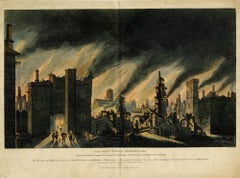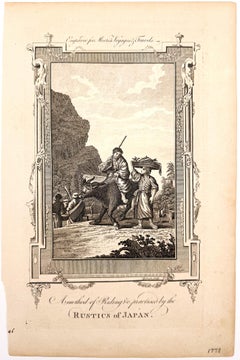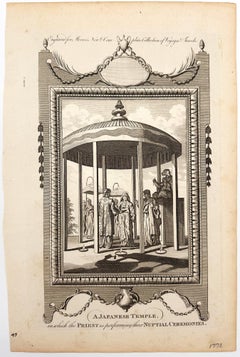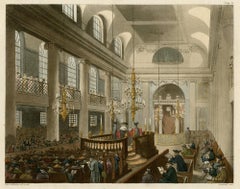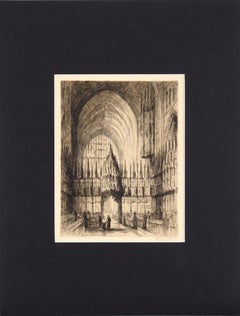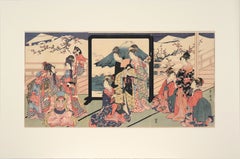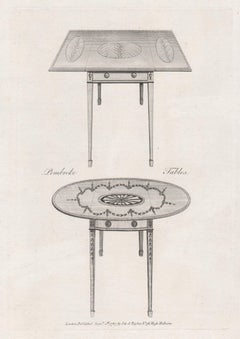English School Interior Prints
to
13
2
Overall Width
to
Overall Height
to
586
441
126
119
48
36
34
30
21
15
14
11
9
2
3
1
1
8
7
8
12
3
9
5
5
4
4
4
3
2
2
2
2
2
2
2
2
2
1
1
1
1
10
9
6
5
4
9
Style: English School
The Great Fire of London, 1666
By James Stow
Located in Middletown, NY
A rare early 19th century view of the Great Fire of London over Ludgate, enhanced with hand coloring.
London: Robert Wilkinson, 1811.
Copperplat...
Category
Early 19th Century English School Interior Prints
Materials
Handmade Paper, Engraving, Watercolor
College of Physicians, from Ackermann's "Microcosm of London."
Located in Middletown, NY
Pugin, Augustus Charles & Rowlandson, Thomas (after).
College of Physicians, from Ackermann's "Microcosm of London."
London: Rudolph Ackermann, 1808. Hand-colored lithograph, 9 1/4 ...
Category
Early 19th Century English School Interior Prints
Materials
Handmade Paper, Watercolor, Lithograph
Rustics of Japan – English School, 18th century
Located in Middletown, NY
A Method of Riding as Practised by the Rustics of Japan.
One plate from A new and complete collection of voyages and travels containing all that have been remarkable from the earlies...
Category
Late 18th Century English School Interior Prints
Materials
Watercolor, Handmade Paper, Engraving
A Japanese Temple – English School, 18th century
Located in Middletown, NY
18th century image of a priest presiding over a traditional Japanese nuptual ceremony.
One plate from A new and complete collection of voyages and travels containing all that have b...
Category
Late 18th Century English School Interior Prints
Materials
Watercolor, Handmade Paper, Engraving
Synagogue Duke's Palace Houndsditch by Th. Sunderland after Pugin & Rowlandson
Located in Middletown, NY
A faithful architectural rendering of the earliest Ashkenazi synagogue constructed in London; built about 1690, and subsequently destroyed in the Blitz, 1941.
London: Rudolph Ackerm...
Category
Early 19th Century English School Interior Prints
Materials
Handmade Paper, Engraving, Aquatint
Side Board, Hepplewhite English Georgian furniture design engraving
Located in Melbourne, Victoria
'Side Board'
From George Hepplewhite's 'Cabinet-Maker and Upholsterer's Guide', published by I. and J. Taylor in 1788. These engravings are the only evidence of Hepplewhite's style ...
Category
Late 18th Century English School Interior Prints
Materials
Engraving
North View of St. Paul's Cathedral, London English School, 19th century
Located in Middletown, NY
London: Tallis & Co., 1851
Lithograph on cream wove paper, 11 3/4 x 15 3/4 inches (297 x 398 mm), with vaulted margins at the top sheet edge. Significant toning, and some edge wear. ...
Category
Mid-19th Century English School Interior Prints
Materials
Handmade Paper, Lithograph
Side Board, Hepplewhite English Georgian furniture design engraving
Located in Melbourne, Victoria
'Side Board'
From George Hepplewhite's 'Cabinet-Maker and Upholsterer's Guide', published by I. and J. Taylor in 1788. These engravings are the only evidence of Hepplewhite's style ...
Category
Late 18th Century English School Interior Prints
Materials
Engraving
Bidet Shaving and Night Tables, Hepplewhite Georgian furniture design engraving
Located in Melbourne, Victoria
'Bidet Shaving Table and Night Table'
From George Hepplewhite's 'Cabinet-Maker and Upholsterer's Guide', published by I. and J. Taylor in 1788. These en...
Category
Late 18th Century English School Interior Prints
Materials
Engraving
Library Table, Hepplewhite English Georgian furniture design engraving
Located in Melbourne, Victoria
'Library Table'
From George Hepplewhite's 'Cabinet-Maker and Upholsterer's Guide', published by I. and J. Taylor in 1788. These engravings are the only evidence of Hepplewhite's sty...
Category
Late 18th Century English School Interior Prints
Materials
Engraving
Library Case, Hepplewhite English Georgian furniture design engraving
Located in Melbourne, Victoria
'Library Case'
From George Hepplewhite's 'Cabinet-Maker and Upholsterer's Guide', published by I. and J. Taylor in 1788. These engravings are the only evidence of Hepplewhite's styl...
Category
Late 18th Century English School Interior Prints
Materials
Engraving
Dressing Glasses, Hepplewhite English Georgian furniture design engraving
Located in Melbourne, Victoria
'Dressing Glasses'
From George Hepplewhite's 'Cabinet-Maker and Upholsterer's Guide', published by I. and J. Taylor in 1788. These engravings are the o...
Category
Late 18th Century English School Interior Prints
Materials
Engraving
Joseph Nash ca. 1839-49 Frontespice "The Mansions of England in the Olden Time"
By Joseph Nash
Located in Chicago, IL
A hand-colored lithograph by Joseph Nash of the Frontespice "The Mansions of England in the Olden Time", 1839-1849, printed by Charles Joseph Hullmandel (Pub. London: T. M'Lean, 1839...
Category
1830s English School Interior Prints
Materials
Lithograph, Paper
1939-1849 Joseph Nash Hand-Colored Lithograph Chapel, Haddon Hall, Derbyshire
By Joseph Nash
Located in Chicago, IL
A Joseph Nash, ca. 1839-49, hand-colored lithograph on paper, Chapel, Haddon Hall, Derbyshire, plate 25 in the disbound book “The Mansions of England in the Olden Time”, first series...
Category
1830s English School Interior Prints
Materials
Lithograph, Paper
Joseph Nash ca. 1839-1849 Hand-Colored Lithograph, Porch & Corridor
By Joseph Nash
Located in Chicago, IL
A Joseph Nash ca. 1839-49 hand-colored lithograph Porch and Corridor, Ockwells, Berks. from "The Mansions of England in the Olden Time". Printed by Charles Joseph Hullmandel (Pub. L...
Category
1830s English School Interior Prints
Materials
Lithograph, Paper
Related Items
Chester Cathedral - Drypoint Etching in Ink on Paper
Located in Soquel, CA
Chester Cathedral - Drypoint Etching in Ink on Paper
Dramatic drypoint etching by J. Alphege Brewer (British, 1881-1946). This composition shows the interior of Chester Cathedral in Brewer's characteristic style - highly detailed and with strong contrast. The scene encompasses the cathedral from floor to ceiling, capturing the immense size of the building. There are several people in the scene which contribute to the sense of scale.
Signed by hand "J. Alphege Brewer" in the lower right corner.
Titled "Chester Cathedral" in plate, lower left corner.
Includes original card with artist's name.
Presented in a new black mat with foamcore backing.
Mat size: 16"H x 12"W
Paper size: 10.75"H x 7.75"W
James Alphege Brewer was well known in the early 20th century as a producer of color etchings of European cathedrals and other scenes of church, college, and community. He was born July 24, 1881, in the Kensington section of London, England, the son of Henry W. Brewer, noted artist of historical architecture and prominent convert to the Catholic Church, and the grandson of John Sherren Brewer, Jr., “the brilliant editor of the Calendar of Letters of Henry VIII.” His great uncle was E. Cobham Brewer, the polymath who compiled Brewer’s Dictionary of Phrase and Fable. Among his older siblings were the artist Henry C. Brewer and the organist and writer John Francis Brewer.
Brewer attended the Westminster School of Art in London, where his brother Henry also trained. In 1910, he married Florence Emma Lucas, an accomplished painter in oil and watercolor, whose father was the noted landscape artist George Lucas and whose great uncle was David Lucas, the famous engraver for John Constable. Florence's brothers Edwin and George assisted Brewer in the printing of Brewer's etchings.
Brewer exhibited at the Royal Academy (RA) and the Royal Institute of Painters in Watercolour (RI), at the Paris Salon of the Académie des Beaux-Arts, and in the shows of the Royal Cambrian Academy (RCA). He became an associate of the Royal Cambrian Academy in 1929 and a full member in the last two years of his life. He was also a member of the Hampstead Society of Artists, the Society of Graphic Art, and the Ealing Arts Club, where he was first Honorary Art Secretary and then Honorary Art Chairman. Most of Brewer's larger etchings were published by Alfred Bell...
Category
Early 20th Century English School Interior Prints
Materials
Paper, Ink, Drypoint
$396 Sale Price
20% Off
H 16 in W 12 in D 0.25 in
"Toy Horse Dance" Japanese Woodblock Triptych with Beauties and Mt Fuji
Located in Soquel, CA
"Toy Horse Dance" Japanese Woodblock Triptych with Beauties and Mt Fuji
Vibrant three-panel woodblock print by Utagawa Toyohiro (Japanese,...
Category
Early 20th Century English School Interior Prints
Materials
Ink, Rice Paper, Woodcut
Utagawa Toyohiro"Toy Horse Dance" Japanese Woodblock Triptych with Beauties and Mt Fuji, early 1900s
$1,360 Sale Price
20% Off
H 24 in W 36 in D 0.25 in
Cup with Pot - Original Etching and Aquatint by Miguel Ibarz - 1960s
Located in Roma, IT
Hand Signed. Artist's Proof.
Good conditions.
Category
1960s English School Interior Prints
Materials
Etching, Aquatint
$311
H 3.15 in W 3.55 in D 0.04 in
Bow Street Office: Rowlandson Hand-colored Engraving from Microcosm of London
Located in Alamo, CA
An early 19th century print entitled "Bow Street Office", an illustration (Plate 11) from "The Microcosm of London", published in London in 1808 by R. Acker...
Category
Early 1800s English School Interior Prints
Materials
Aquatint, Etching
Thomas RowlandsonBow Street Office: Rowlandson Hand-colored Engraving from Microcosm of London, 1808
$655
H 18.5 in W 20 in D 0.88 in
Don Juan
By Louis Icart
Located in Missouri, MO
Aquating Engraving
Image Size: approx. 20 1/4 x 13 3/8
Framed Size: 28 x 20.5 inches
Pencil Signed Lower Right
Louis Justin Laurent Icart was born in Toulouse in 1890 and died in Paris in 1950. He lived in New York City in the 1920s, where he became known for his Art-Deco color etchings of glamourous women.
He was first son of Jean and Elisabeth Icart and was officially named Louis Justin Laurent Icart. The use of his initials L.I. would be sufficient in this household. Therefore, from the moment of his birth he was dubbed 'Helli'. The Icart family lived modestly in a small brick home on rue Traversière-de-la-balance, in the culturally rich Southern French city of Toulouse, which was the home of many prominent writers and artists, the most famous being Henri de Toulouse-Lautrec.
Icart entered the l'Ecole Superieure de Commerce de Toulouse in order to continue his studies for a career in business, particularly banking (his father's profession). However, he soon discovered the play writings of Victor Hugo (1802-1885), which were to change the course of his life. Icart borrowed whatever books he could find by Hugo at the Toulouse library, devouring the tales, rich in both romantic imagery and the dilemmas of the human condition. It was through Icart's love of the theater that he developed a taste for all the arts, though the urge to paint was not as yet as strong for him as the urge to act.
It was not until his move to Paris in 1907 that Icart would concentrate on painting, drawing and the production of countless beautiful etchings, which have served (more than the other mediums) to indelibly preserve his name in twentieth century art history.
Art Deco, a term coined at the 1925 Paris Exposition des Arts Decoratifs, had taken its grip on the Paris of the 1920s. By the late 1920s Icart, working for both publications and major fashion and design studios, had become very successful, both artistically and financially. His etchings reached their height of brilliance in this era of Art Deco, and Icart had become the symbol of the epoch. Yet, although Icart has created for us a picture of Paris and New York life in the 1920s and 1930s, he worked in his own style, derived principally from the study of eighteenth-century French masters such as Jean Antoine Watteau, François Boucher and Jean Honoré Fragonard.
In Icart's drawings, one sees the Impressionists Degas...
Category
1920s English School Interior Prints
Materials
Engraving, Aquatint
Four Koa Wood Framed 18th C. Engravings from Captain Cook's 3rd Voyage Journal
By John Webber
Located in Alamo, CA
A grouping of four framed engravings of Hawaii, Tahiti, Tonga and Vancouver Island from the atlas of the official British Admiralty sanctioned journal of Captain Cook's 3rd Voyage entitled "A Voyage to the Pacific Ocean Undertaken by the Command of His Majesty, for Making Discoveries in the Northern Hemisphere", published upon completion of the voyage in London in 1784 by Strahan & Cadell. These engravings were made from drawings by John Webber (1752-1793), who was the artist on Captain James Cook's 3rd and final voyage of discovery. The set of engravings includes: "A Canoe of the Sandwich Islands, the Rowers Masked", Plate 65 in the atlas; "A Dance in Otaheite" (Tahiti), Plate 28; "King of the Friendly Islands" (Tonga), plate 20; "Inside of a House in Nootka Sound" (Canada), plate 42.
These engravings are professionally framed in Koa wood, the same wood as was used to make the canoes of the ancient Hawaiians. Koa wood is legendary in Hawaii. Not only is this amazing wood native to Hawaii, but it is known for the deep rich colors and varied grain pattern. Koa has an honored heritage in Hawaii and is highly revered and sacred. The word “koa” means “warrior” in Hawaiian. The warriors of King Kamehameha the Great, created canoes and weapons from a wood plentiful on the Big Island of Hawaii. This wood became synonymous with the warriors themselves, and it became known as koa.
These four engravings would make a wonderful grouping for a display of 2, 3 or 4 prints. They may be purchased separately or in groups on 1stDibs. Their listing Reference #'s are: LU117324682432, LU117324682022, LU117324684052 and LU117324684062. A discount is available for a grouping depending on the number of items included.
Hawaii was discovered by Captain Cook (1728-1779) during this voyage. Hawaii was originally called The Sandwich Islands in honor of The Earl of Sandwich...
Category
1780s English School Interior Prints
Materials
Engraving
$9,575
H 20.75 in W 26.75 in D 0.88 in
"King of the Friendly Islands" (Tonga); Engraving from Captain Cook's 3rd Voyage
By John Webber
Located in Alamo, CA
"Poulaho, King of the Friendly Islands, Drinking Kava" is an engraving created by William Sharp (1749-1824), from a drawing by John Webber (1752-1793), who was the artist on Captain James Cook's 3rd and final voyage of discovery. It was published in the atlas of "A Voyage to the Pacific Ocean Undertaken by the Command of His Majesty, for Making Discoveries in the Northern Hemisphere", the official British Admirality sanctioned journal published upon completion of the voyage in London in 1784 by Strahan & Cadell.
Captain Cook visited Tonga on his 3rd voyage, which he named The Friendly Islands because of the warm welcome he and his crew received, unlike some of the other more hostile Pacific islands. The engraving depicts Cook and his men observed a kava ceremony at the village of Mu’a on Tongatapu. King Paulaho sits in the centre foreground, his back to the spectator with a man kneeling before him. The ceremonial mat depicted behind Paulaho indicates that nobody was allowed to sit behind him. The figure in the centre holds a single cup, referring to the Tongan custom of offering the cup to the king first. Kava is native to the islands of the South Pacific and was first described for English readers in 1768 by Captain James Cook. The kava root has been used for centuries as a central feature of ceremonies and celebrations because it was able to bring about a calming and pleasant social atmosphere. The root was crushed and processed into coconut milk to become the focal ceremonial beverage, simply referred to as kava.
This engraving is presented in a Koa wood frame and a white mat. Koa wood is legendary in Hawaii. There are occasional faint spots, but the print is otherwise in very good condition. This amazing Koa wood is native to Hawaii and it is known for the deep rich colors and varied grain pattern. Koa has an honored heritage in Hawaii and is highly revered and sacred. The word “koa” means “warrior” in Hawaiian. The warriors of King Kamehameha the Great, created canoes and weapons from a wood plentiful on the Big Island of Hawaii. This wood became synonymous with the warriors themselves, and it became known as koa.
There are three other engravings listed from the official journal of Captain Cook's 3rd voyage available that are presented in identical Koa wood frames and mats (LU117324682422, LU117324684052, LU117324684032). They would make a wonderful grouping for a display of 2, 3 or 4 prints. A discount is available for a grouping depending on the number of items included.
Captain Cook is remembered as one of the greatest explorers and navigators in history. His explorations included Australia, New Zealand and islands of the South Pacific and the northwest coast of North America. Hawaii was discovered by Captain Cook during this voyage. Hawaii was originally called The Sandwich Islands in honor of The Earl of Sandwich...
Category
1780s English School Interior Prints
Materials
Engraving
$2,375
H 18.25 in W 23.5 in D 0.88 in
Landscape with Window and Chair
Located in Fairlawn, OH
Landscape with Window and Chair
Mezzotint on wove paper, 2000
Signed in pencil lower right (see photo)
Edition: 150 (93/150) (see photo)
Special Presentation Print for the Print Club...
Category
Early 2000s English School Interior Prints
Materials
Mezzotint
Kabuki actor Nakamura Shikan II by Utagawa Kunisada Edo Japanese Woodblock Print
Located in Soquel, CA
Kabuki actor Nakamura Shikan II by Utagawa Kunisada Japanese Woodblock Print
Wonderful portrait of Nakamura Shikan II, a prominent kabuki actor, in the role of Kisen Hoshi Toyokuni ...
Category
1820s English School Interior Prints
Materials
Printer's Ink, Rice Paper, Woodcut
$357 Sale Price
35% Off
H 21.75 in W 16.75 in D 1.25 in
Home David Hockney (Six Fairy Tales from the Brothers Grimm) Clandeboye House
Located in New York, NY
From David Hockney’s celebrated Six Fairy Tales from the Brothers Grimm portfolio, an image from the story of ‘The boy who left home to learn fear’. Hockney chose this story for its ...
Category
1960s English School Interior Prints
Materials
Etching, Aquatint
$9,000
H 24.75 in W 17.75 in
'Jesus and the Woman at the Well, ' by Amand-Durand, Engraving
By Armand Durand
Located in Oklahoma City, OK
This early 19th century framed 35" x 31" engraving by artist Amand-Durand depcits an etching of 'Jesus and the Woman at the Well,' after the Dutch master, Rembrandt van Rijn. This poignant Biblical story is depicted by Arman-Durand in Rembrandt style...
Category
Early 19th Century English School Interior Prints
Materials
Engraving
$1,200 Sale Price
20% Off
H 30.5 in W 26.5 in D 1.5 in
Inside the castle by David Hockney (Six Fairy Tales from the Brothers Grimm)
Located in New York, NY
From David Hockney’s celebrated Six Fairy Tales from the Brothers Grimm portfolio, an image of the story ‘The boy who left home to learn fear’. Hockney chose this story for its obscu...
Category
1960s English School Interior Prints
Materials
Etching, Aquatint
$2,250
H 17.75 in W 16 in
Previously Available Items
Six Hepplewhite Georgian furniture design engravings
Located in Melbourne, Victoria
Six Hepplewhite Georgian furniture design engravings :
'Pembroke Tables'
'Card Tables'
'Double Chest of Drawers'
'Urn stands'
'Dressing Drawers'
...
Category
Late 18th Century English School Interior Prints
Materials
Engraving
English School interior prints for sale on 1stDibs.
Find a wide variety of authentic English School interior prints available for sale on 1stDibs. Works in this style were very popular during the 19th Century, but contemporary artists have continued to produce works inspired by this movement. Many Pop art paintings were created by popular artists on 1stDibs, including and Thomas Rowlandson. Frequently made by artists working with Engraving, and Handmade Paper and other materials, all of these pieces for sale are unique and have attracted attention over the years. Not every interior allows for large English School interior prints, so small editions measuring 9.06 inches across are also available. Prices for interior prints made by famous or emerging artists can differ depending on medium, time period and other attributes. On 1stDibs, the price for these items starts at $90 and tops out at $400, while the average work sells for $90.
Recently Viewed
View AllMore Ways To Browse
Herbert Gentry
Hermes Bag Painting
Highwaymen Art
Hildegard Hamilton
Hispano Suiza
Hollywood Hills Painting
Honey Kurlander
Honore Sharrer
Horatio Mcculloch
Howard Barron
Howard Rogers
Huge Mythological Painting
Hungarian Jewish Paintings
Hunt Horse And Hounds
Hunt Slonem Cardinal
Hunt Slonem Lories
Hyam Hyams
Ian Houston
